
Chondrus crispus—commonly called Irish moss or carrageenan moss —is a species of red algae which grows abundantly along the rocky parts of the Atlantic coasts of Europe and North America. In its fresh condition it is soft and cartilaginous, varying in color from a greenish-yellow, through red, to a dark purple or purplish-brown. The principal constituent is a mucilaginous body, made of the polysaccharide carrageenan, which constitutes 55% of its dry weight. The organism also consists of nearly 10% dry weight protein and about 15% dry weight mineral matter, and is rich in iodine and sulfur. When softened in water it has a sea-like odour. Because of the abundant cell wall polysaccharides, it will form a jelly when boiled, containing from 20 to 100 times its weight of water.

Palmaria palmata, also called dulse, dillisk or dilsk, red dulse, sea lettuce flakes, or creathnach, is a red alga (Rhodophyta) previously referred to as Rhodymenia palmata. It grows on the northern coasts of the Atlantic and Pacific Oceans. It is a well-known snack food. In Iceland, where it is known as söl, it has been an important source of dietary fiber throughout the centuries.

Fucus serratus is a seaweed of the north Atlantic Ocean, known as toothed wrack, serrated wrack, or saw rack.

Padina pavonica, commonly known as the peacock's tail, is a small brown alga found in the Indian Ocean, the Pacific Ocean, the Atlantic Ocean and the Mediterranean Sea. It inhabits pools in the littoral zone typically with clayey, silty or sandy sediments. Other habitats include rocks and shell fragments in the shallow sublittoral, seagrass meadows, mangrove roots and coral reefs on tidal flats.

Gastroclonium reflexum is a small red alga (Rhodophyta) reported from Ireland and Britain.
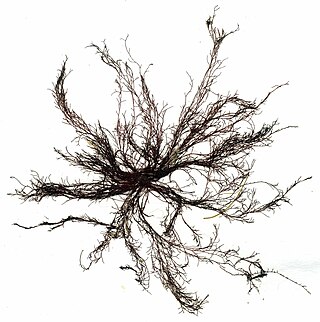
Polysiphonia is a genus of filamentous red algae with about 19 species on the coasts of the British Isles and about 200 species worldwide, including Crete in Greece, Antarctica and Greenland. Its members are known by a number of common names. It is in the order Ceramiales and family Rhodomelaceae.
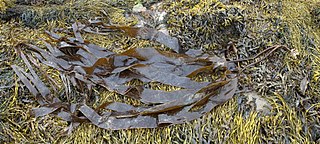
Laminaria digitata is a large brown alga in the family Laminariaceae, also known by the common name oarweed. It is found in the sublittoral zone of the northern Atlantic Ocean.
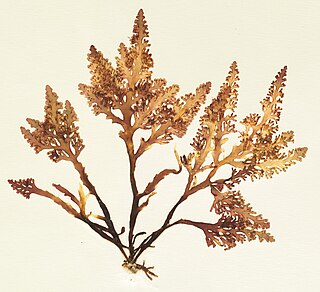
Osmundea pinnatifida is a species of red alga known by the common name pepper dulse.

Fucus distichus or rockweed is a species of brown alga in the family Fucaceae to be found in the intertidal zones of rocky seashores in the Northern Hemisphere, mostly in rock pools.

Laminaria hyperborea is a species of large brown alga, a kelp in the family Laminariaceae, also known by the common names of tangle and cuvie. It is found in the sublittoral zone of the northern Atlantic Ocean. A variety, Laminaria hyperborea f. cucullata is known from more wave sheltered areas in Scandinavia.

Cordylecladia erecta is a species of red algae in the family Rhodymeniaceae. It is found in the north east Atlantic Ocean and the Mediterranean Sea and is the type species of the genus.
Lobophora variegata is a species of small thalloid brown alga which grows intertidally or in shallow water in tropical and warm temperate seas. It has three basic forms, being sometimes ruffled, sometimes reclining and sometimes encrusting, and each form is typically found in a different habitat. This seaweed occurs worldwide. It is the type species of the genus Lobophora, the type locality being the Antilles in the West Indies.

Bonnemaisonia hamifera is a species of red alga in the family Bonnemaisoniaceae. Originally from the Pacific Ocean, it has been introduced into the northeastern Atlantic Ocean, where it is considered invasive on European coasts. It exists in two phases which, at one time, were thought to be different species; a medium-sized feathery form attached to other seaweeds, and a small tufted form known as Trailliella.

Mastocarpus papillatus, sometimes called Turkish washcloth, black tar spot, or grapestone is a species of red algae in the family Phyllophoraceae. It is sometimes confused with the distantly related Turkish towel which is of a similar texture but larger. The specific epithet papillatus is due to the nipple-like projections on the female gametophyte which can give the texture of a terrycloth washcloth found at a Turkish bath.
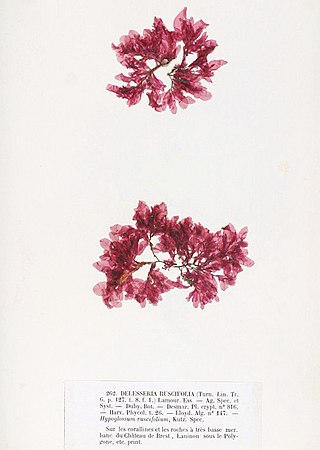
Apoglossum ruscifolium is a small red marine seaweed.

Phycodrys rubens is a red marine alga of up to 30 cm long.

Padina boergesenii, commonly known as the leafy rolled-blade alga, is a species of small brown alga found in the tropical and subtropical western Atlantic Ocean, the Mediterranean Sea, and the Pacific Ocean. This seaweed was named in honour of the Danish botanist and phycologist Frederik Børgesen.
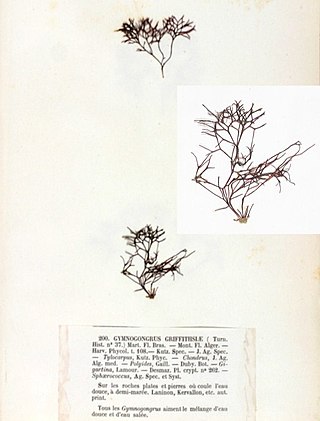
Gymnogongrus griffithsiae is a small uncommon seaweed.

Catenella caespitosa is a small red marine alga.

Dictyota dichotoma is a species of Brown algae found in the temperate western and eastern Atlantic Ocean, the Mediterranean Sea, the Black Sea, the Red Sea and the western Indian Ocean.


















